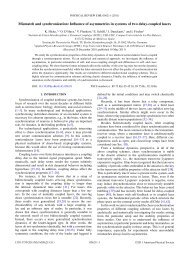DBI Analysis of Open String Bound States on Non-compact D-branes
DBI Analysis of Open String Bound States on Non-compact D-branes
DBI Analysis of Open String Bound States on Non-compact D-branes
Create successful ePaper yourself
Turn your PDF publications into a flip-book with our unique Google optimized e-Paper software.
CHAPTER 3. SUPERSTRINGS 47to again make the exp<strong>on</strong>ent <str<strong>on</strong>g>of</str<strong>on</strong>g> x match the mass <str<strong>on</strong>g>of</str<strong>on</strong>g> the appropriate state, the first fewterms in the expansi<strong>on</strong> <str<strong>on</strong>g>of</str<strong>on</strong>g> f NS readRam<strong>on</strong>d sectorf NS (x) = 1x −1 2 + 8x 0 + 36x 1 2 + 128x 1 + 402x 3 2 + 1152x 2 + . . .. (3.42)The mass-shell c<strong>on</strong>diti<strong>on</strong> applied to the Ram<strong>on</strong>d sector delivers us the mass formulaα ′ M 2 =+∞∑n=1α i −nα i n ++∞∑m=1d i −md i m, (3.43)where again we incorporated the c<strong>on</strong>diti<strong>on</strong> a R = 0. Applying α i −n or d i −m thus raisesthe mass with n or m units respectively.The good news is that we see that there is no tachy<strong>on</strong> in the open string R sector!The, at first sight, bad news is that the groundstate is degenerate. However, we will beable to turn this to our advantage later <strong>on</strong>. Recall that the d modes satisfy the algebra{d µ m, d ν n} = η µν δ m+n,0 .The big difference with the NS case is that this time around there are anticommutingzero modes which, as the above equati<strong>on</strong> dem<strong>on</strong>strates, satisfy a ten-dimensi<strong>on</strong>al Cliffordalgebra 5 (except for a factor <str<strong>on</strong>g>of</str<strong>on</strong>g> 2, cfr. Eq. 3.3, which can be accounted for by rescalingthe d 0 operators with a factor √ 2.), indeed c<strong>on</strong>firming that the groundstate is degenerate.Given that the d µ ’s satisfy a Clifford algebra, the groundstates in the R sector shouldform a representati<strong>on</strong> <str<strong>on</strong>g>of</str<strong>on</strong>g> this algebra, and hence we can write thatd µ 0 |a〉 = √ 1 Γ µ2ba|b〉, (3.44)with (|a〉, |b〉) groundstates and Γ µ ba forming a basis <str<strong>on</strong>g>of</str<strong>on</strong>g> the 2⌊D/2⌋ -dimensi<strong>on</strong>al Cliffordalgebra. Given that D = 10 in this case, this is a 32-dimensi<strong>on</strong>al algebra. It can beshown that these ten-dimensi<strong>on</strong>al spinors can actually be reduced to eight-dimensi<strong>on</strong>alMajorana-Weyl spinors having 16 real comp<strong>on</strong>ents, amounting to two times eight groundstates <str<strong>on</strong>g>of</str<strong>on</strong>g> two opposite chiralities; sixteen in total if you prefer. We denote these by |a〉and |ā〉. For a further discussi<strong>on</strong> <strong>on</strong> how <strong>on</strong>e can combine the different d µ 0 operators into“raising” and “lowering” operators, see §3.1 in [17].The fact that the groundstate is degenerate immediatly makes the number <str<strong>on</strong>g>of</str<strong>on</strong>g> statesin the R sector grow c<strong>on</strong>siderably bigger compared to the NS sector. On the other hand,the NS sector c<strong>on</strong>tains twice as many mass levels, because the b operators are half-integermoded. This already points out two discrepancies between both spectra: a difference inmass levels, and a difference in states in corresp<strong>on</strong>ding mass levels. Noticing that theR ground states are space-time spinors, we can identify them as space-time fermi<strong>on</strong>s.Acting <strong>on</strong> them with the raising operators keeps creating space-time spinor states, and5 Remember that switching to space-time light-c<strong>on</strong>e gauge did not eliminate the zero modes.
















